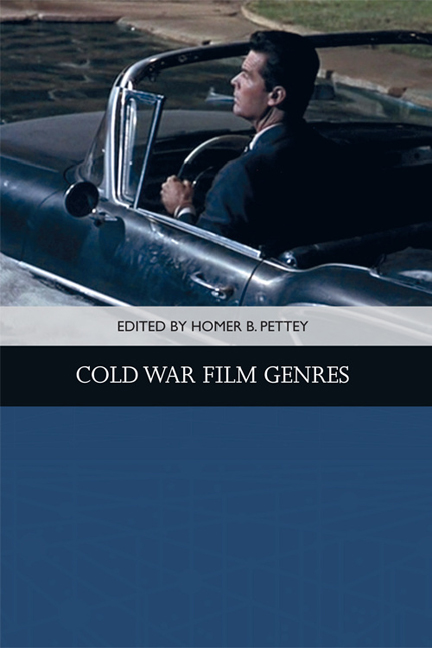Book contents
- Frontmatter
- Contents
- List of Illustrations
- Acknowledgments
- Notes on the Contributors
- 1 Introduction: Cold War Genres and the Rock-and-Roll Film
- 2 Social Factors in Brainwashing Films of the 1950s and 1960s
- 3 The Berlin Crisis? Piffl!: Billy Wilder’s Cold War Comedy, One, Two, Three
- 4 The Small Adult Film: A Prestige Form of Cold War Cinema
- 5 “I’m Lucky – I Had Rich Parents”: Disability and Class in the Postwar Biopic Genre
- 6 Rogue Nation, 1954: History, Class Consciousness, and the “Rogue Cop” Film
- 7 Internal Enmity: Hollywood’s Fragile Home Stories in the 1950s and 1960s
- 8 Suburban Sublime
- 9 Domestic Containment for Whom? Gendered and Racial Variations on Cold War Modernity in the Apartment Plot
- 10 Success and the Single Girl: Urban Romances of Working Women
- 11 Paris Loves Lovers and Americans Loved Paris: Gender, Class, and Modernity in the Postwar Hollywood Musical
- 12 Straight to Baby: Scoring Female Jazz Agency and New Masculinity in Henry Mancini’s Peter Gunn
- Index
4 - The Small Adult Film: A Prestige Form of Cold War Cinema
Published online by Cambridge University Press: 24 April 2021
- Frontmatter
- Contents
- List of Illustrations
- Acknowledgments
- Notes on the Contributors
- 1 Introduction: Cold War Genres and the Rock-and-Roll Film
- 2 Social Factors in Brainwashing Films of the 1950s and 1960s
- 3 The Berlin Crisis? Piffl!: Billy Wilder’s Cold War Comedy, One, Two, Three
- 4 The Small Adult Film: A Prestige Form of Cold War Cinema
- 5 “I’m Lucky – I Had Rich Parents”: Disability and Class in the Postwar Biopic Genre
- 6 Rogue Nation, 1954: History, Class Consciousness, and the “Rogue Cop” Film
- 7 Internal Enmity: Hollywood’s Fragile Home Stories in the 1950s and 1960s
- 8 Suburban Sublime
- 9 Domestic Containment for Whom? Gendered and Racial Variations on Cold War Modernity in the Apartment Plot
- 10 Success and the Single Girl: Urban Romances of Working Women
- 11 Paris Loves Lovers and Americans Loved Paris: Gender, Class, and Modernity in the Postwar Hollywood Musical
- 12 Straight to Baby: Scoring Female Jazz Agency and New Masculinity in Henry Mancini’s Peter Gunn
- Index
Summary
Pressured by its upstart televisual rival (the new medium began full commercial operation in 1948), the American cinema in the initial decades of the Cold War found some success in a generally declining marketplace by exploring two production types that pushed the industry in quite opposite directions. Big-budget event films (the antecedent of contemporary tentpole [major] productions) made the most of then innovative wide-screen processes and color film stock and, to give an impression of “largeness,” they also featured an expanded roster of name players and a running time so extended an intermission was often required. Small-scale, black-and-white, realist projects rivaled the similar international art films then doing profitable business in specialized urban venues. Both these forms of alternative cinema, which enjoyed growing reputations for being serious and prestigious releases, were, in the language of the exhibition trade, “sure seaters” or certain to fill auditoriums week in, week out (see Wilinsky).
It is no coincidence that the U.S. trend in small adult film production picked up steam in the early 1950s precisely when this niche end of the exhibition business began to enjoy a substantial boom owing to the unexpected popularity of foreign releases, especially from Italy. A significant change in audience taste was taking place, and there was a reaction among U.S. exhibitors (who promoted venues for screening art films from abroad) and producers who catered to this new fashion in their own way and in financial and institutional circumstances different from those under which foreign filmmakers operated (see Balio). This was the very same period when the social-problem film became an insistent, and prestige-claiming, presence on the nation's screens (see Cagle). Unfortunately, the prominent place that the social-problem film rightly claims in histories of the period has obscured the significance of small adult filmmaking, with which it shares some common features even if there are fundamental differences between the two domestic prestige (as opposed to entertainment) types, as this chapter will attempt to outline.
In contrast to the international art cinema, which was largely an auteurist phenomenon, small adult releases were usually literary adaptations, with their production linked closely to more outré Broadway and publishing fashions, a trend that can be traced to Elia Kazan's screening of Tennessee Williams's Broadway smash production, A Streetcar Named Desire (1951) (See Palmer/ Bray).
- Type
- Chapter
- Information
- Cold War Film Genres , pp. 62 - 78Publisher: Edinburgh University PressPrint publication year: 2018



